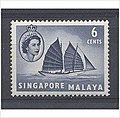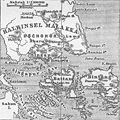Portal:Singapore
 Map of Singapore Singapore, officially the Republic of Singapore, is an island country and city-state in Southeast Asia. The country's territory comprises one main island, 63 satellite islands and islets, and one outlying islet. It is about one degree of latitude (137 kilometres or 85 miles) north of the equator, off the southern tip of the Malay Peninsula, bordering the Strait of Malacca to the west, the Singapore Strait to the south along with the Riau Islands in Indonesia, the South China Sea to the east, and the Straits of Johor along with the State of Johor in Malaysia to the north.
In its early history, Singapore was a maritime emporium known as Temasek and subsequently a major constituent part of several successive thalassocratic empires. Its contemporary era began in 1819, when Stamford Raffles established Singapore as an entrepôt trading post of the British Empire. In 1867, Singapore came under the direct control of Britain as part of the Straits Settlements. During World War II, Singapore was occupied by Japan in 1942 and returned to British control as a Crown colony following Japan's surrender in 1945. Singapore gained self-governance in 1959 and, in 1963, became part of the new federation of Malaysia, alongside Malaya, North Borneo, and Sarawak. Ideological differences led to Singapore's expulsion from the federation two years later; Singapore became an independent sovereign country in 1965. After early years of turbulence and despite lacking natural resources and a hinterland, the nation rapidly developed to become one of the Four Asian Tigers. As a highly developed country, it has one of the highest PPP-adjusted GDP per capita. It is also identified as a tax haven. Singapore is the only country in Asia with a AAA sovereign credit rating from all major rating agencies. It is a major aviation, financial, and maritime shipping hub and has consistently been ranked as one of the most expensive cities to live in for expatriates and foreign workers. Singapore ranks highly in key social indicators: education, healthcare, quality of life, personal safety, infrastructure, and housing, with a home-ownership rate of 88 percent. Singaporeans enjoy one of the longest life expectancies, fastest Internet connection speeds, lowest infant mortality rates, and lowest levels of corruption in the world. It has the third highest population density of any country, although there are numerous green and recreational spaces as a result of urban planning. With a multicultural population and in recognition of the cultural identities of the major ethnic groups within the nation, Singapore has four official languages: English, Malay, Mandarin, and Tamil. English is the common language, with exclusive use in numerous public services. Multi-racialism is enshrined in the constitution and continues to shape national policies. Singapore is a parliamentary republic and its legal system is based on common law. While the country is de jure a multi-party democracy with free elections, the government under the People's Action Party (PAP) wields widespread control and political dominance. One of the five founding members of ASEAN, Singapore is also the headquarters of the Asia-Pacific Economic Cooperation Secretariat, the Pacific Economic Cooperation Council Secretariat, and is the host city of many international conferences and events. Singapore is also a member of the United Nations, the World Trade Organization, the East Asia Summit, the Non-Aligned Movement, and the Commonwealth of Nations. (Full article...)Selected article - "Disneyland with the Death Penalty" is a 4,500-word article about Singapore written by William Gibson. His first major piece of non-fiction, it was first published as the cover story for Wired magazine's September/October 1993 issue (1.4). The article followed Gibson's observations of the architecture, phenomenology and culture of Singapore, and the clean, bland and conformist impression the city-state conveyed during his stay. Its title and central metaphor – Singapore as Disneyland with the death penalty – was a reference to the authoritarian artifice the author perceived the city-state to be. Singapore, Gibson detailed, was lacking any sense of creativity or authenticity, absent of any indication of its history or underground culture. He found the government to be pervasive, corpocratic and technocratic, and the judicial system rigid and draconian. Singaporeans were characterized as consumerists of insipid taste. The article was accentuated by local news reports of criminal trials by which the author illustrated his observations, and bracketed by contrasting descriptions of the Southeast Asian airports he arrived and left by. (Full article...) Selected picture The Parliament House of Singapore. Thid building was designed to represent a contemporary architectural expression of stateliness and authority. Its prism-shaped top was designed by former president Ong Teng Cheong. Read more... General imagesThe following are images from various Singapore-related articles on Wikipedia.
Selected biography - Teresa Hsu Chih (7 July 1898 – 7 December 2011) (Chinese: 许哲; pinyin: Xǔ Zhe), was a Chinese-born Singaporean charity worker, social worker, yoga teacher, nurse, and supercentenarian known affectionately as "Singapore's Mother Teresa", in recognition for her active lifelong devotion in helping the aged, sick, and destitutes locally. The retired nurse was the founder of the non-profit charities—Heart to Heart Service and the Home for the Aged Sick, one of the first homes for the aged sick in Singapore. She had been a social worker in China and Paraguay and a nurse in England, before coming to Singapore to start similar non-profit charities since 1961. Despite being a supercentenarian, Hsu was still involved in charity work and was one of very few supercentenarians who were recognised for reasons other than their longevity. She had spent almost all her savings on feeding and housing the poor and the elderly, all of whom were younger than she was, while she herself led a simple and humble lifestyle. In 2005, she received the Special Recognition Award from the Singapore government in recognition of her contribution to the country. (Full article...) Did you know (auto-generated)
In this month
More did you know -
Selected panoramaSungei Serangoon (Malay for Serangoon River; Chinese: 实龙岗河) is a river in the north-eastern part of Singapore. The 6-kilometre river starts as a canal near Tampines Road, and flows through Hougang, Sengkang, Punggol, Lorong Halus and Pasir Ris, before emptying into the Serangoon Harbour. The river is also known as the Serangoon Estuary. Singapore topicsRelated portalsSoutheast Asia Other Countries Tasks
CategoriesWikiprojectsAssociated WikimediaThe following Wikimedia Foundation sister projects provide more on this subject:
Discover Wikipedia using portals |






























































